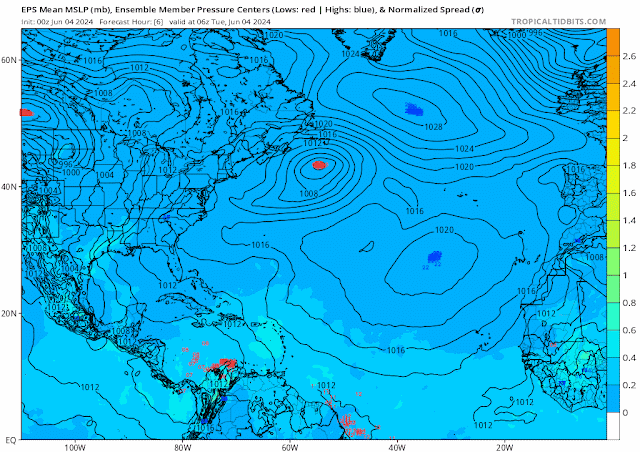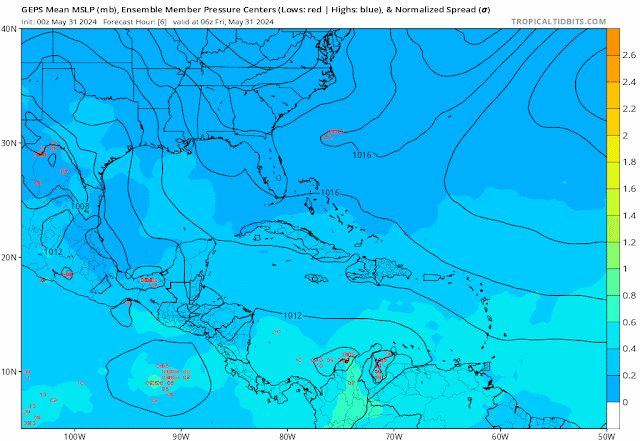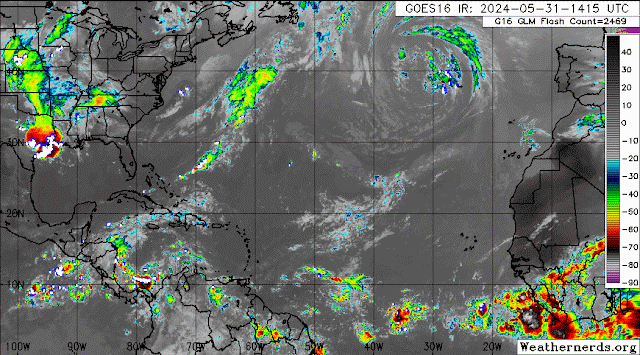There is a strong monsoon storm southwest of the African coast, behind a tropical wave near 26 West. Although these waves are moving through the moist inter-tropical convergence zone (ITCZ), there are no signs of low pressure developing along the axis of these waves or anywhere near the waves.
A persistent, stationary upper-level trough that extends northeast from the Caribbean into the Atlantic continues to produce strong gusty winds, lightning, and heavy rains that are causing flash floods and deadly mudslides. Jamaica, Haiti, and the Dominican Republic have been drenched by these heavy rains and storms over the weekend and the past few days.
Monsoon storms are also present south of Panama and Costa Rica.
I am still monitoring the northwest Caribbean for moisture rising up from there by early next week that could bring gusty winds, heavy rains for western Cuba, and possibly Florida. This is not for sure, so for now I am just monitoring since ensemble models are still hinting that something will rise out of the northwest Caribbean.
The latest Global Tropic Hazards Outlook map now show a greater than 20% chance for the Bay of Campeche and the Northwest Caribbean for 2nd week June 12-18 and 3rd week June 19-25. So we have to continue watching these areas this month.
RTW
000
ABNT20 KNHC 041747 TWOAT Tropical Weather Outlook NWS National Hurricane Center Miami FL Issued by the NWS Weather Prediction Center College Park MD 200 PM EDT Tue Jun 4 2024 For the North Atlantic...Caribbean Sea and the Gulf of Mexico: Tropical cyclone formation is not expected during the next 7 days. $$ Forecaster Otto/Taylor
-----------------------------------------------------------------
160 ACCA62 KNHC 041748 TWOSAT Perspectiva sobre las Condiciones del Tiempo en el Trópico Centro Nacional de Huracanes del SNM Miami FL Emitido por el Centro de Predicción del Tiempo del SNM College Park MD 200 PM EDT martes 4 de junio de 2024 Para el Atlántico Norte...Mar del Caribe y el Golfo de México: No se espera la formación de ciclones tropicales durante los próximos 7 días. $$ Pronosticador Otto/Taylor *** Este producto ha sido procesado automáticamente utilizando un programa de traducción y puede contener omisiones y errores. El Servicio Nacional de Meteorología no puede garantizar la precisión del texto convertido. De haber alguna duda, el texto en inglés es siempre la versión autorizada. ***
-----------------------------------------------------------------
927 AXNT20 KNHC 041805 TWDAT Tropical Weather Discussion NWS National Hurricane Center Miami FL 1805 UTC Tue Jun 4 2024 Tropical Weather Discussion for North America, Central America Gulf of Mexico, Caribbean Sea, northern sections of South America, and Atlantic Ocean to the African coast from the Equator to 31N. The following information is based on satellite imagery, weather observations, radar and meteorological analysis. Based on 1200 UTC surface analysis and satellite imagery through 1740 UTC. ...SPECIAL FEATURES... HEAVY RAINFALL IN HISPANIOLA, IN JAMAICA, AND IN EASTERN CUBA: A persistent western Caribbean Sea upper level trough will continue to support the significant rainshowers through Friday. The threats to land are: dangerous lightning, heavy rain, and gusty winds, through Friday. It is possible that heavy rain may lead to flash flooding and mudslides, especially in areas of Hispaniola where the ground remains saturated from earlier recent heavy rain events. Global models show that this afternoon and Thursday afternoon will be the days with the most significant precipitation, in the north central Dominican Republic and in the northeastern part of Haiti. It is possible also that significant rainfall may reach eastern Cuba, and the Cayman Islands, where abundant moisture will be present. Please, refer to bulletins and forecasts that are from your local weather bureau office for more detailed information. ...TROPICAL WAVES... An Atlantic Ocean tropical wave is along 26W, from 11N southward, moving westward about 10 knots. Any close precipitation is related to the monsoon trough or to the ITCZ. An Atlantic Ocean tropical wave is along 39W, from 11N southward, moving westward about 10 knots. Any close precipitation is related to the ITCZ. An Atlantic Ocean tropical wave is along 54W, from 13N southward, moving westward about 10 knots. Any close precipitation is related to the ITCZ. The earlier central Caribbean Sea tropical wave that was close to 72W, at 04/0600 UTC, was eliminated from the map analysis. Most of the moisture that was accompanying this feature is outside the Caribbean Sea at this time. The earlier western Caribbean Sea tropical wave that was close to 85W/86W, at 04/0600 UTC, was eliminated from the map analysis. This wave has become caught up in the nearby NE-to-SW oriented upper level trough. ...MONSOON TROUGH/ITCZ... The monsoon trough passes through the coastal plains of Guinea- Bissau close to 11N15W, to 08N19W, to 06N25W. The ITCZ is along 04N/05N between 27W and 36W. Precipitation: scattered strong is from 05N to 08N between 17W and 21W. Scattered moderate to isolated strong is elsewhere within 90 nm on either side of the rest of the line 08N14W 05N23W 05N30W 05N36W 06N43W 06N49W 08N54W 14N62W. ...GULF OF MEXICO... A broad surface ridge extends from an Atlantic Ocean 1017 mb 32N74W high pressure center, to the coastal waters of the U.S.A. Gulf coast states. Moderate seas are in the western half of the area. The sea heights range from 6 feet to 7 feet in the Texas coastal waters. Slight seas are in the rest of the Gulf of Mexico. Mostly fresh to some strong SE winds are from 90W westward. Moderate or slower winds are in the remainder of the Gulf of Mexico. A weak Atlantic ridge extends SW into the NE Gulf, and will dominate the basin through the next several days. This pattern will support generally moderate to fresh SE to S winds in the western Gulf, fresh to occasionally strong near the Yucatan Peninsula and in the NW Gulf, and gentle to moderate winds in the eastern Gulf through late Wed. By Thu, the ridge will weaken, allowing for winds to diminish somewhat. Hazy conditions due to agricultural fires over Central America and Mexico will continue for the next couple of days, reducing visibility to around 3 nm at times, mainly over the western half of the Gulf. ...CARIBBEAN SEA... Please, read the SPECIAL FEATURES section, for information about the heavy rainfall event in Hispaniola, in Jamaica, and in the eastern sections of Cuba. Cyclonic wind flow is covering much of the northern half of the area, with a persistent and deep layer trough. A surface trough currently is in the Windward Passage. Precipitation: scattered to numerous strong is in the Windward Passage. Scattered moderate to isolated strong is from 14N to Jamaica between 75W and 79W, and in the eastern half of the Dominican Republic. Mostly fresh to some strong SE winds are from the Windward Passage eastward. Moderate or slower winds are in the remainder of the Caribbean Sea. Mostly moderate to slightly rough seas are between 64W and 73W. Mostly moderate to some slight seas are in the remainder of the Caribbean Sea. The 24-hour rainfall totals in inches, for the period that ended at 04/1200 UTC, are: 1.47 in Guadeloupe; 0.31 in San Juan in Puerto Rico; 0.29 in Trinidad; 0.15 in Montego Bay in Jamaica; and 0.04 in Tegucigalpa in Honduras. This information is from the Pan American Temperature and Precipitation Tables/MIATPTPAN. The monsoon trough is along 12N/13N, from 75W off the coast of Colombia, beyond Nicaragua, and into the Pacific Ocean. Precipitation: scattered to numerous strong is within 150 nm to the south of the monsoon trough between 75W and 79W; and from 06N to 09N between 78W and 80W to the south of Panama. Other isolated moderate to locally strong is elsewhere from 14N southward from 70W westward. Weak high pressure extends across the western Atlantic along 31N-32N. The associated pressure gradient across the region will support fresh winds across the east-central Caribbean this morning, with seas to near 8 ft. Winds and seas will then diminish modestly through Wed night. A deep layered upper- level trough from the W Atlantic to the W Caribbean will continue to support active thunderstorms across north-central portions through today. As this feature moves E-NE across the Atlantic, associated weather will shift across the NE Caribbean this evening through Thu. Fresh trade winds will return to southeast portions of the basin Thu evening through early Sat. ...ATLANTIC OCEAN... A cold front passes through 31N39W, to 26N48W. A surface trough continues, from 26N48W, to a 1013 mb low pressure center that is near 28N63W. The surface trough continues from the 1013 mb low pressure center, to the Windward Passage. Precipitation: scattered strong is within 480 nm to the southwest of the 1013 mb low pressure center. Widely scattered moderate to isolated strong is elsewhere from 10N to 21N between 60W and 63W, and from 20N northward between 50W and 70W. Mostly moderate seas cover the entire area in general. The comparatively highest sea heights, range from 4 feet to 6 feet. Some smaller areas of sea heights of 4 feet or less are mixed into the areas of predominantly moderate seas. Fresh NE winds are to the southeast of 31N16W 23N19W 21N30W 20N40W 19N60W. Fresh to strong southerly winds are between 60W and 70W, to the south of the 28N60W 25N70W-Windward Passage surface trough. Moderate or slower winds are in the remainder of the Atlantic Ocean. A frontal trough extends from 27N55W to 1013 mb low pressure near 28.5N62.5W to the SE Bahamas. A deep-layered upper trough across the W Atlantic and into the W Caribbean will shift E-NE across the region through Thu, and maintain active thunderstorms between 55W and 70W, that will shift E and NE through Thu. The upper trough is expected to aid in strengthening of the low pressure, which will move NE and exit the area waters Wed morning. Strong to near gale-force SW winds are expected ahead of this low pressure this afternoon and evening as it moves across the NE waters. Weak high pressure will begin to build across the basin Wed then shift slowly E-NE Thu through Fri night. A weak front may drop into the NW waters Sat. mt/ss
That's a lot of moisture rising up from the Caribbean from June 5-12.
If that were to happen then this would be a flooding potential for Cuba, Florida and the Bahamas.




.png)






















.gif)











.png)










.png)

